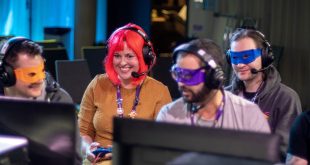Oculus Go is exactly what the still nascent VR industry needed. It’s a VR headset that simply works. At a price that’s attractive to anyone curious about VR. And it’s backed by a wide range of compatible software. Launched at GDC, we got the chance to be amongst the first to test it out.
The Go is a dedicated all-in-one device, so users don’t need to own certain high-end handsets in order to use it, as with the Samsung Gear VR. It also means anyone in a household can use it, without someone having to lose access to their smartphone for the duration. And at $199 it’s a lot cheaper than a high-end smartphone as well.
It’s lightweight and comfortable to wear, the display has an impressive 2,560×1,440 resolution, and the impressive optics mean the overall visual quality is far better than you might expect. It’s not got the horsepower of a tethered headset of course, but graphics are detailed enough and the refresh rate was steady, with Oculus pushing a smoother-than expected refresh rate of 72Hz. All in all it’s great for shorter-to-medium experiences.
Vitally, it comes with a dedicated controller, so developers looking to port their titles across to the new headset have a single control system to target and make the most of. However, there’s no external tracking kit of course, to keep things simple, so the headset and controller’s position isn’t tracked, just the way they rotate at fixed location. This is it’s most serious sacrifice both for price and ease of use.
In practice that means games such as the upcoming Vacation Simulator, which was demoed for us on Oculus Rift, won’t work as you can’t reach out and grab objects in the world in the same way.
That said, we were impressed with a Catan demo, a virtual take on the popular board game, letting you sit and play a game with distant friends, while also chatting and interacting as you would if you were sitting around a real table. It supports crossplay with Rift as well, hugely increasing the potential player base at launch.
Then we played They Suspect Nothing, a humourous selection of smaller games where you play as a human in a robot-dominated world, completing work-like tasks in order to maintain your cover. We operated a crane in order to smash and pick up varying run-away robots. It’s not a complex game, but it was immediate, fun and graphically impressive.
Oculus hasn’t announced what the graphics chipset is inside the headset, rumours point to a Snaphdragon 821 chipset, but when it’s doing this good of a job it doesn’t really matter.
It feels unfair to criticise something that works so well, but there’s nothing particularly clever about Oculus Go. The market really shouldn’t have had to wait this long for such an affordable dedicated headset. But it’s here now and the VR market is all the better for it.
Or rather it’s not quite here yet, for Oculus hasn’t announced a release date, or even given us a rough idea of when it will be available. But we should certainly see the device on shelves sometime this year.

 MCV/DEVELOP News, events, research and jobs from the games industry
MCV/DEVELOP News, events, research and jobs from the games industry




